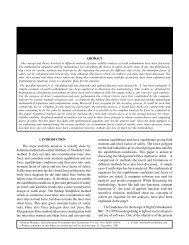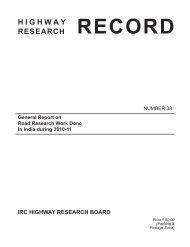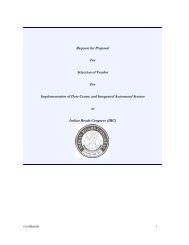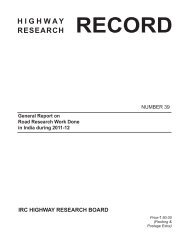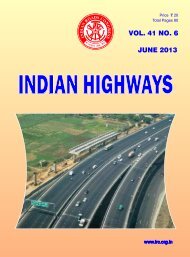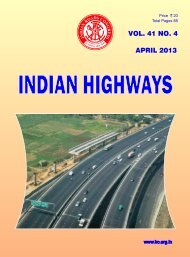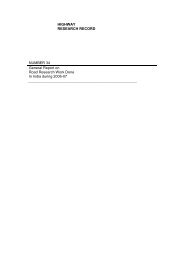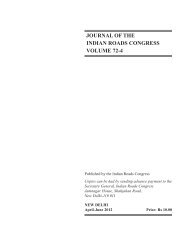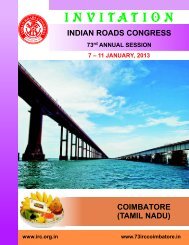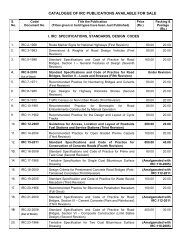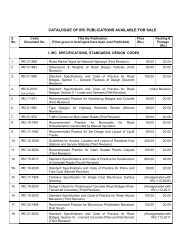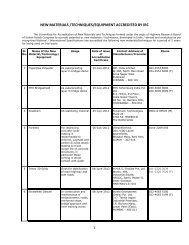A Review of Highway Agencies in the South Asia Region
A Review of Highway Agencies in the South Asia Region
A Review of Highway Agencies in the South Asia Region
Create successful ePaper yourself
Turn your PDF publications into a flip-book with our unique Google optimized e-Paper software.
A <strong>Review</strong> <strong>of</strong> <strong>Highway</strong> <strong>Agencies</strong> <strong>in</strong> <strong>the</strong> <strong>South</strong> <strong>Asia</strong> <strong>Region</strong><br />
Table 2.9: Composition <strong>of</strong> staff <strong>in</strong> Karnataka Public Works, Ports & Inland Water Transport Department (example)<br />
Post Sanctioned Filled up Vacant Vacant as Share<br />
<strong>of</strong> Sanctioned<br />
Eng<strong>in</strong>eer <strong>in</strong> Chief 1 1 0 0%<br />
Chief Eng<strong>in</strong>eer 3 3 0 0%<br />
Super<strong>in</strong>tend<strong>in</strong>g Eng<strong>in</strong>eers 21 21 0 0%<br />
Executive Eng<strong>in</strong>eers 64 61 3 5%<br />
Assistant Executive Eng<strong>in</strong>eers 344 341 3 1%<br />
Assistant Eng<strong>in</strong>eers 1,119 857 262 23%<br />
Junior Eng<strong>in</strong>eers 863 703 160 19%<br />
Total 2,415 1,987 428 18%<br />
Source: Karnataka Public Works, Ports & Inland Water Transport Department.<br />
scheme is described merely as <strong>the</strong> entitlement <strong>of</strong> an employee to wage <strong>in</strong>creases as (s)he<br />
grows older.<br />
Most senior post<strong>in</strong>gs, <strong>the</strong> responsibility <strong>of</strong> <strong>the</strong> parent m<strong>in</strong>istry, are promotional posts for<br />
<strong>of</strong>ficials from with<strong>in</strong> <strong>the</strong> highway agency. These posts tend to be filled by older <strong>of</strong>ficers<br />
near<strong>in</strong>g <strong>the</strong>ir superannuation. The tenure <strong>in</strong> senior position, <strong>the</strong>refore, is generally short,<br />
between one and three years. The higher echelons are thus relatively old <strong>in</strong> age, a potential<br />
barrier for a fresh approach to <strong>the</strong> management <strong>of</strong> highway agencies.<br />
Scarce attention is paid to improv<strong>in</strong>g knowledge and skills with<strong>in</strong> highway agencies.<br />
Membership <strong>of</strong> <strong>the</strong> respective national <strong>in</strong>stitutes <strong>of</strong> eng<strong>in</strong>eers is limited to half <strong>of</strong> <strong>the</strong><br />
respond<strong>in</strong>g organizations and <strong>the</strong> concept <strong>of</strong> pr<strong>of</strong>essional registration is unknown.<br />
Participat<strong>in</strong>g <strong>in</strong> committees <strong>of</strong> such or similar <strong>in</strong>stitutes is observed <strong>in</strong> 40 percent <strong>of</strong> cases.<br />
Despite <strong>the</strong> importance attached to tra<strong>in</strong><strong>in</strong>g <strong>in</strong> <strong>the</strong> available policy and vision statements,<br />
tra<strong>in</strong><strong>in</strong>g does not receive much attention. In 60 percent <strong>of</strong> <strong>the</strong> highway agencies, junior and<br />
assistant eng<strong>in</strong>eers do not undergo any tra<strong>in</strong><strong>in</strong>g. Tra<strong>in</strong><strong>in</strong>g is limited only to senior <strong>of</strong>ficials<br />
and, that too, is <strong>of</strong>ten not targeted; <strong>in</strong> 20 percent <strong>of</strong> <strong>the</strong> highway agencies tra<strong>in</strong><strong>in</strong>g is only<br />
given to eng<strong>in</strong>eers at <strong>the</strong> level <strong>of</strong> Executive Eng<strong>in</strong>eer and above. Highly skilled staff is an<br />
exception: 30 percent <strong>of</strong> <strong>the</strong> agencies employ Ph.Ds and 20 percent employ postgraduates.<br />
2.6 Reforms Undertaken and Success Achieved<br />
Governments and highway agencies have realized that <strong>the</strong>ir approaches would not yield <strong>the</strong><br />
desired outcomes <strong>in</strong> view <strong>of</strong> <strong>the</strong> economic and social development that is tak<strong>in</strong>g place <strong>in</strong> <strong>the</strong><br />
region. Therefore, a variety <strong>of</strong> reforms have already been implemented across <strong>South</strong> <strong>Asia</strong>.<br />
Some <strong>of</strong> <strong>the</strong>se have been highlighted <strong>in</strong> <strong>the</strong> previous sections <strong>of</strong> this chapter.<br />
In addition, Figure 2.18 shows o<strong>the</strong>r reforms that have been implemented across <strong>the</strong> region.<br />
Most common is <strong>the</strong> digitization <strong>of</strong> <strong>in</strong>formation and processes. Limited procurement and<br />
f<strong>in</strong>ancial management reforms have also been undertaken. In 70 percent <strong>of</strong> <strong>the</strong> cases<br />
covered <strong>in</strong> <strong>the</strong> study, rudimentary management <strong>in</strong>formation systems have been put <strong>in</strong><br />
place, and <strong>in</strong> 40 percent <strong>of</strong> <strong>the</strong> cases budget track<strong>in</strong>g studies were undertaken. In India, RTI<br />
is complied with by all but one agency covered <strong>in</strong> <strong>the</strong> study. However, grievance redressal<br />
procedures are only implemented <strong>in</strong> 30 percent <strong>of</strong> cases. There are also efforts to <strong>in</strong>crease<br />
transparency and accountability and, to this end, standard bid documents and transparent<br />
bidd<strong>in</strong>g procedures are <strong>in</strong> place <strong>in</strong> 70 percent <strong>of</strong> <strong>the</strong> cases.<br />
41



